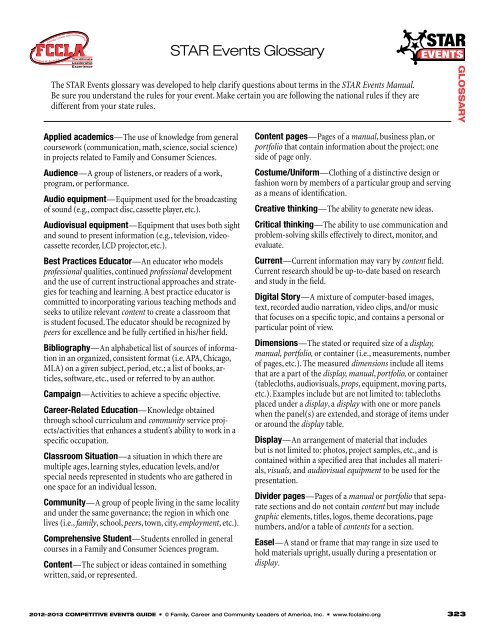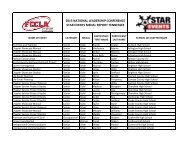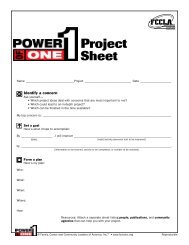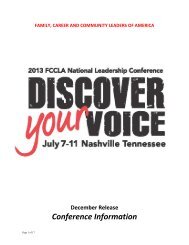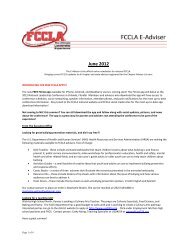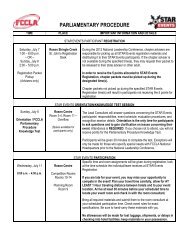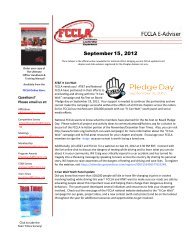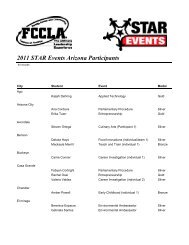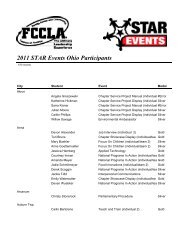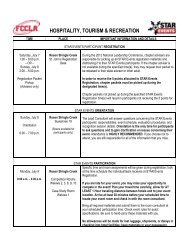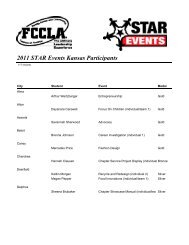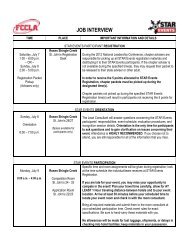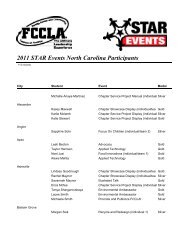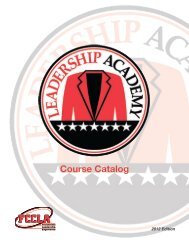STAR Events Glossary - fccla
STAR Events Glossary - fccla
STAR Events Glossary - fccla
Create successful ePaper yourself
Turn your PDF publications into a flip-book with our unique Google optimized e-Paper software.
<strong>STAR</strong> <strong>Events</strong> <strong>Glossary</strong><br />
The <strong>STAR</strong> <strong>Events</strong> glossary was developed to help clarify questions about terms in the <strong>STAR</strong> <strong>Events</strong> Manual.<br />
Be sure you understand the rules for your event. Make certain you are following the national rules if they are<br />
different from your state rules.<br />
Applied academics—The use of knowledge from general<br />
coursework (communication, math, science, social science)<br />
in projects related to Family and Consumer Sciences.<br />
Audience—A group of listeners, or readers of a work,<br />
program, or performance.<br />
Audio equipment—Equipment used for the broadcasting<br />
of sound (e.g., compact disc, cassette player, etc.).<br />
Audiovisual equipment—Equipment that uses both sight<br />
and sound to present information (e.g., television, videocassette<br />
recorder, LCD projector, etc.).<br />
Best Practices Educator—An educator who models<br />
professional qualities, continued professional development<br />
and the use of current instructional approaches and strategies<br />
for teaching and learning. A best practice educator is<br />
committed to incorporating various teaching methods and<br />
seeks to utilize relevant content to create a classroom that<br />
is student focused. The educator should be recognized by<br />
peers for excellence and be fully certified in his/her field.<br />
Bibliography—An alphabetical list of sources of information<br />
in an organized, consistent format (i.e. APA, Chicago,<br />
MLA) on a given subject, period, etc.; a list of books, articles,<br />
software, etc., used or referred to by an author.<br />
Campaign—Activities to achieve a specific objective.<br />
Career-Related Education—Knowledge obtained<br />
through school curriculum and community service projects/activities<br />
that enhances a student’s ability to work in a<br />
specific occupation.<br />
Classroom Situation—a situation in which there are<br />
multiple ages, learning styles, education levels, and/or<br />
special needs represented in students who are gathered in<br />
one space for an individual lesson.<br />
Community—A group of people living in the same locality<br />
and under the same governance; the region in which one<br />
lives (i.e., family, school, peers, town, city, employment, etc.).<br />
Comprehensive Student—Students enrolled in general<br />
courses in a Family and Consumer Sciences program.<br />
Content—The subject or ideas contained in something<br />
written, said, or represented.<br />
Content pages—Pages of a manual, business plan, or<br />
portfolio that contain information about the project; one<br />
side of page only.<br />
Costume/Uniform—Clothing of a distinctive design or<br />
fashion worn by members of a particular group and serving<br />
as a means of identification.<br />
Creative thinking—The ability to generate new ideas.<br />
Critical thinking—The ability to use communication and<br />
problem-solving skills effectively to direct, monitor, and<br />
evaluate.<br />
Current—Current information may vary by content field.<br />
Current research should be up-to-date based on research<br />
and study in the field.<br />
Digital Story—A mixture of computer-based images,<br />
text, recorded audio narration, video clips, and/or music<br />
that focuses on a specific topic, and contains a personal or<br />
particular point of view.<br />
Dimensions—The stated or required size of a display,<br />
manual, portfolio, or container (i.e., measurements, number<br />
of pages, etc.). The measured dimensions include all items<br />
that are a part of the display, manual, portfolio, or container<br />
(tablecloths, audiovisuals, props, equipment, moving parts,<br />
etc.). Examples include but are not limited to: tablecloths<br />
placed under a display, a display with one or more panels<br />
when the panel(s) are extended, and storage of items under<br />
or around the display table.<br />
Display—An arrangement of material that includes<br />
but is not limited to: photos, project samples, etc., and is<br />
contained within a specified area that includes all materials,<br />
visuals, and audiovisual equipment to be used for the<br />
presentation.<br />
Divider pages—Pages of a manual or portfolio that separate<br />
sections and do not contain content but may include<br />
graphic elements, titles, logos, theme decorations, page<br />
numbers, and/or a table of contents for a section.<br />
Easel—A stand or frame that may range in size used to<br />
hold materials upright, usually during a presentation or<br />
display.<br />
2012–2013 Competitive events Guide ■ © Family, Career and Community Leaders of America, Inc. ■ www.<strong>fccla</strong>inc.org 323<br />
GLossARY
<strong>STAR</strong> <strong>Events</strong> <strong>Glossary</strong> (continued)<br />
Educational Enhancement Opportunity—Knowledge<br />
obtained through job shadowing, informational interviews,<br />
or career research projects that enhances a specific occupational<br />
area.<br />
Electronic Portfolio—An electronic portfolio, also known<br />
as an e-portfolio or digital portfolio, is a collection of<br />
electronic evidence assembled and managed by a user,<br />
usually on the Web (also called Webfolio). Such electronic<br />
evidence may include inputted text, electronic files such<br />
as Microsoft Word and Adobe ® PDF files, images, multimedia,<br />
blog entries, and hyperlinks. E-portfolios are both<br />
demonstrations of the user's abilities and platforms for<br />
self-expression, and, if they are online, they can be maintained<br />
dynamically over time. Some e-portfolio applications<br />
permit varying degrees of audience access, so the same<br />
portfolio might be used for multiple purposes.<br />
Employment—The work in which one is engaged; an activity<br />
to which one devotes time; may or may not include wages.<br />
EPA Climate Ambassadors—Middle or high school<br />
students who meet at least one of the criteria found on the<br />
EPA Climate Ambassador website, www.epa.gov/climateforaction/lead/become.htm,<br />
and submit an online Climate<br />
Ambassador form.<br />
Fabric Care—Method(s) of cleaning and making suitable<br />
for wear.<br />
Fabric Characteristics—Information about a fabric<br />
including, ease of use, special requirements of constructing<br />
garments with this fabric, limitations/advantages of using<br />
the fabric, and typical uses.<br />
Family—Two or more persons, sometimes living under<br />
one roof, who nurture and support one another physically<br />
and emotionally, share resources, share responsibility for<br />
decisions, share values and goals, and have commitment to<br />
one another; environment created by caring people—regardless<br />
of blood, legal ties, adoption, or marriage—where<br />
individuals learn to be productive members of society; a<br />
context for discovery where one can comfortably accept<br />
challenges, make mistakes, have successes, be self-expressive,<br />
and grow as an individual.<br />
Fiber Content—The types and amounts of different fibers<br />
in a fabric or garment.<br />
File folder—A letter-size folder<br />
81 /2" x 11" with one fold on lower<br />
horizontal edge and open on the other<br />
3 sides; may have a tab at the top or may be straight cut.<br />
Within the file folder, each set of materials should be stapled<br />
separately. File folder may be any color.<br />
Flip chart—A chart consisting of sheets hinged on one side<br />
that can be flipped over to present information sequentially.<br />
Focus group—A small group of individuals, not participating<br />
in the event, who test and/or evaluate an idea,<br />
event, or product with the intent of suggesting revisions for<br />
improvement.<br />
graphic—A picture, border, map, graphic font, or graph<br />
used for illustration or demonstration.<br />
Hardcopy—Readable printed copy of the output of a<br />
machine, such as a computer.<br />
In-depth service project—A detailed project that<br />
addresses one specific interest, concern, or need.<br />
Individual event—An event completed by one person.<br />
Lesson plan—A set of plans for teaching a concept that<br />
includes objective(s), plan of action, time schedule, resources,<br />
supplies, equipment, and evaluation process.<br />
Mannequin—A full or partial human form that is or is<br />
close to actual body size which is used to display a garment<br />
or ensemble.<br />
Manual—An arrangement of materials in an FCCLA<br />
scrapbook containing information about an in-depth chapter<br />
service project or chapter program of work that may<br />
include but is not limited to pictures, news clippings, and<br />
program booklets.<br />
Model—A 3-D object which represents, in detail, the intent<br />
of a final version of a product.<br />
national programs—Frameworks for FCCLA action that<br />
encourage members to enhance their personal growth and<br />
build leadership skills.<br />
Occupational student—An occupational student is one<br />
who has completed or is currently taking a concentrated<br />
program that prepares individuals for paid employment.<br />
Peer—A person who is equal to another in a particular<br />
category such as ability, age, rank, and/or qualifications.<br />
Peer education—To provide with information, teach, or<br />
instruct a person or group equal in ability, age, rank, and/or<br />
qualifications (e.g., teens teaching teens).<br />
Photo Album—A collection of photographs, either presented<br />
in a digital or printed format.<br />
Plain paper—81 /2" x 11" paper with no graphics or design.<br />
Paper may be any solid color. Watermark is not allowed.<br />
2012–2013 Competitive events Guide ■ © Family, Career and Community Leaders of America, Inc. ■ www.<strong>fccla</strong>inc.org 324<br />
GLossARY
<strong>STAR</strong> <strong>Events</strong> <strong>Glossary</strong> (continued)<br />
Planning Process—A five-step method (identify<br />
concerns, set a goal, form a plan, act, and follow up) to help<br />
FCCLA chapter members and advisers plan individual,<br />
group, or chapter activities.<br />
Pointer—See prop. Laser pointers are not allowed.<br />
Portfolio—A record/collection of a person’s work<br />
organized in a format that best suits the project and meets<br />
the requirements of the event. Portfolios may be either<br />
hardcopy or electronic. See event specifications for<br />
allowable format.<br />
Postconsumer Item—Any item which has been discarded<br />
by an end consumer. Examples include, but are<br />
not limited to, textiles, housewares, paper goods, sporting<br />
goods, etc.<br />
Problem solving—The ability to recognize problems and<br />
devise and implement plans of action to solve the problems.<br />
Professional—Worthy of the high standards of a<br />
profession.<br />
Project identification page—A page at the front of a<br />
document or display containing headings specifically called<br />
for by event rules.<br />
Prop—An object used to enhance a theme or presentation<br />
(e.g., book, puppet, pointer, etc.) that does not include visuals,<br />
audiovisuals, or costumes/uniforms. Live objects are not<br />
allowed. Props do not include content.<br />
Prototype Formula—The ingredients, their quantities,<br />
and the process directions used to produce a food item.<br />
Reliable—Sources should be respected in the field and information<br />
found in the source should be able to be backed<br />
up by other sources or legitimate research.<br />
Resources—Any source of information or assistance<br />
in carrying out a project. May be any medium (e.g. book,<br />
internet, chapter member, speaker, etc.) but must be cited<br />
appropriately when used.<br />
School relationships—Relationships within an<br />
educational institution (e.g., student to student, student<br />
to educator, student to organization, etc.).<br />
Seating and Traffic Standards—Standards for the<br />
amount of space needed for and around seating areas with<br />
various levels of traffic produced by the National Kitchen<br />
and Bath Association (Kitchen Planning Guidelines 8 & 9).<br />
NKBA Planning Guidelines can be found online at:<br />
http://www.nkba.com/guidelines/kitchen.aspx.<br />
Skit—A short, rehearsed, theatrical sketch that could<br />
include interaction with others (also called role play).<br />
Sound business practices—Practices that are comprehensive,<br />
ethical, realistic, and profitable.<br />
Stewardship Project—A project carried out by participants<br />
in their home, school, or community which actively<br />
works to counteract, reverse, or prevent the presence of an<br />
environmental concern or issue.<br />
Team—A team may be composed of one, two, or three<br />
participants from the same chapter and/or school with the<br />
following exception: the Parliamentary Procedure team may<br />
have four to eight participants from the same chapter and/<br />
or school.<br />
Team event—An event that can be completed by an entire<br />
chapter but may be presented by a team of one,<br />
two, or three members.<br />
Technology—A method, system, or process for handling<br />
a specific, technical problem.<br />
Uniform—See costume.<br />
visual equipment—Equipment used for visual projection<br />
without sound (e.g., projector, laptop, electronic tablet).<br />
virtual Poster—An online multimedia poster with text,<br />
photos, videos, graphics, sounds, drawings, data attachments<br />
or other digital items.<br />
visuals—Posters, charts, slides, transparencies, presentation<br />
software, etc., which include content.<br />
2012–2013 Competitive events Guide ■ © Family, Career and Community Leaders of America, Inc. ■ www.<strong>fccla</strong>inc.org 325<br />
GLossARY


